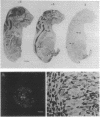Abstract
Recent studies have shown that there exists a family of protein kinases structurally and functionally related to the yeast cell cycle regulatory kinase cdc2 [Meyerson, M., Faha, B., Su, L.-K., Harlow, E. & Tsai, L.-H. (1991) Cold Spring Harbor Symp. Quant. Biol. 56, 177-186 and Meyerson, M., Enders, G. H., Wu, C.-L., Su, L.-K., Gorka, C., Nelson, C., Harlow, E. & Tsai, L.-H. (1992) EMBO J. 11, 2909-2917]. Two members of cdc2 family, p34cdc2 (also named cdk1) and cdk2, have been identified in mammalian cells. cdk1 kinase regulates the progression from G2 to M phase, and cdk2 kinase has been proposed to regulate the progression from G1 to S phase. In this work, we have cloned and structurally characterized a third member of the cdc2 kinase family with 58% amino acid sequence identity to mouse cdk1 and 61% identity to human cdk2. We call this kinase neuronal cdc2-like kinase (nclk) because, in contrast to either cdk1 or cdk2, nclk is expressed at high levels in terminally differentiated neurons no longer in the cell cycle. Previous studies have shown [Hisanaga, S., Kusubata, M., Okumura, E. & Kishimoto, T. (1991) J. Biol. Chem. 266, 21798-21803 and Guan, R. J., Hall, F. L. & Cohlberg, J. A. (1992) J. Neurochem. 58, 1365-1371] that cdk1 kinase, but not other structurally defined protein kinases, could phosphorylate the repeated Lys-Ser-Pro (KSP) motifs found in mammalian high and middle molecular mass neurofilament subunits in vitro, but the precise molecular nature of the endogenous neuronal KSP kinase has remained undefined. The structural similarity of nclk to cdk1 kinase and its high level of expression in terminally differentiated neurons suggest that nclk may play a role in the phosphorylation of the neurofilament KSP repeats in vivo, a function distinct from cell cycle regulation.
Full text
PDF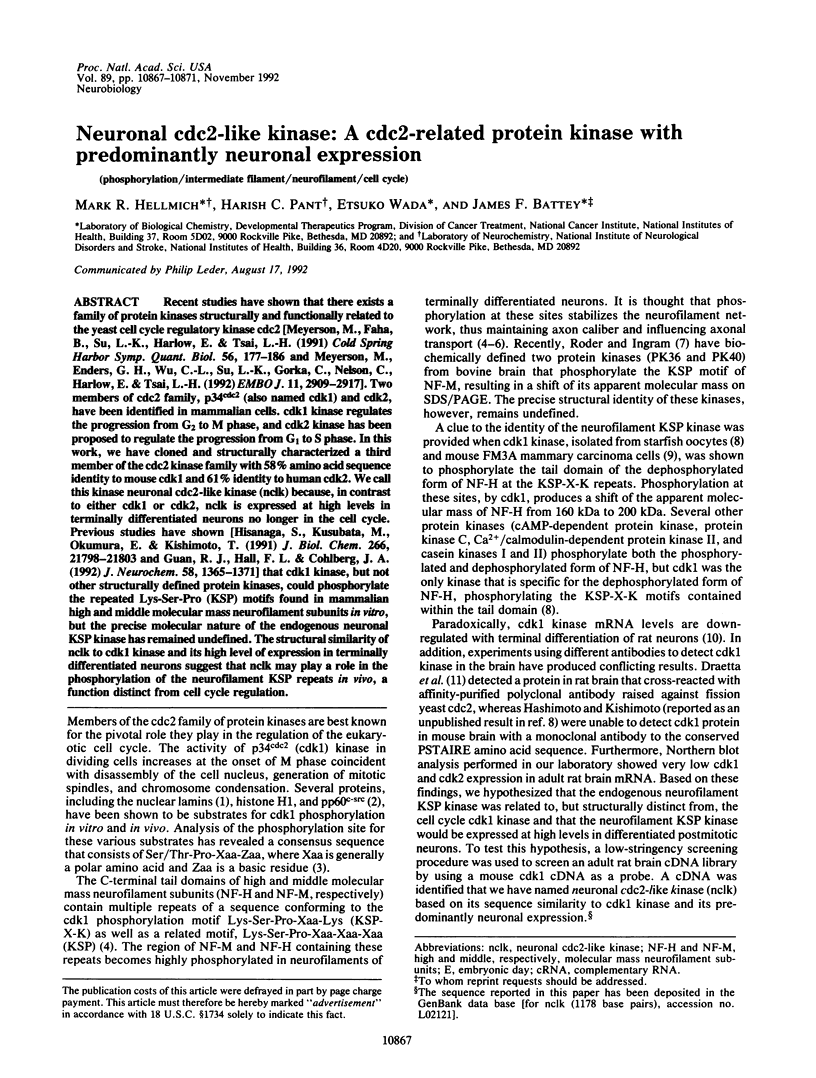
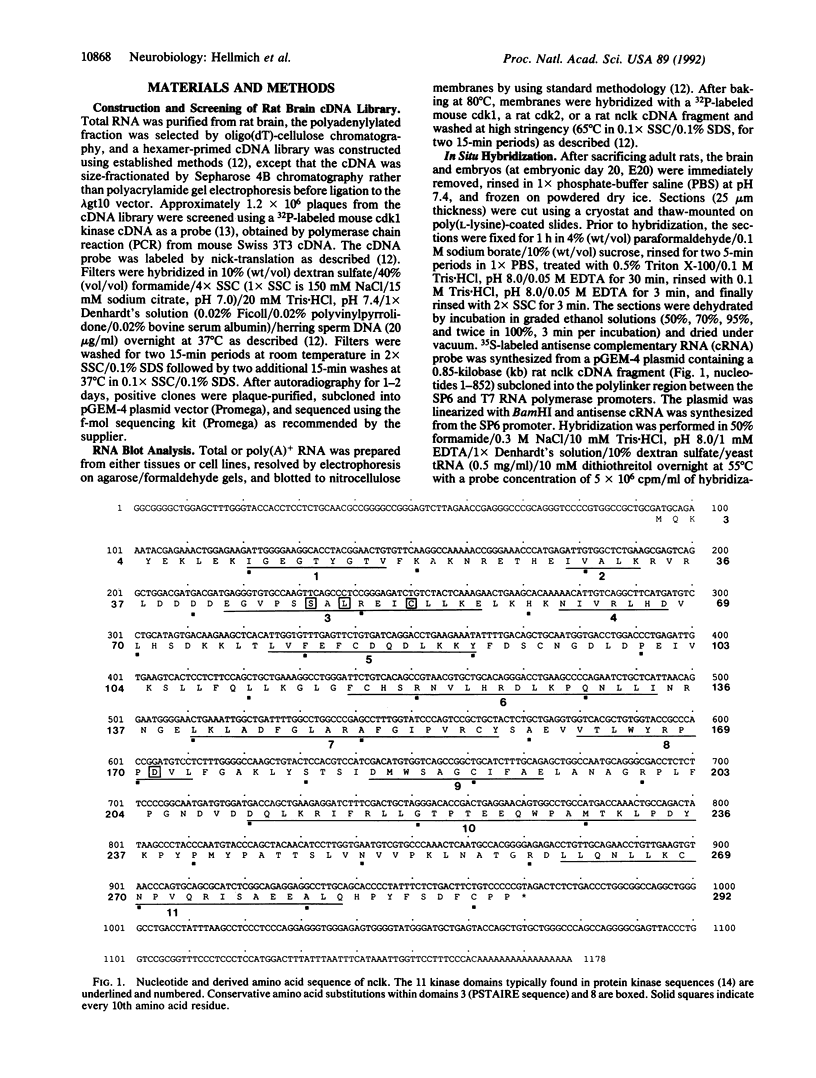
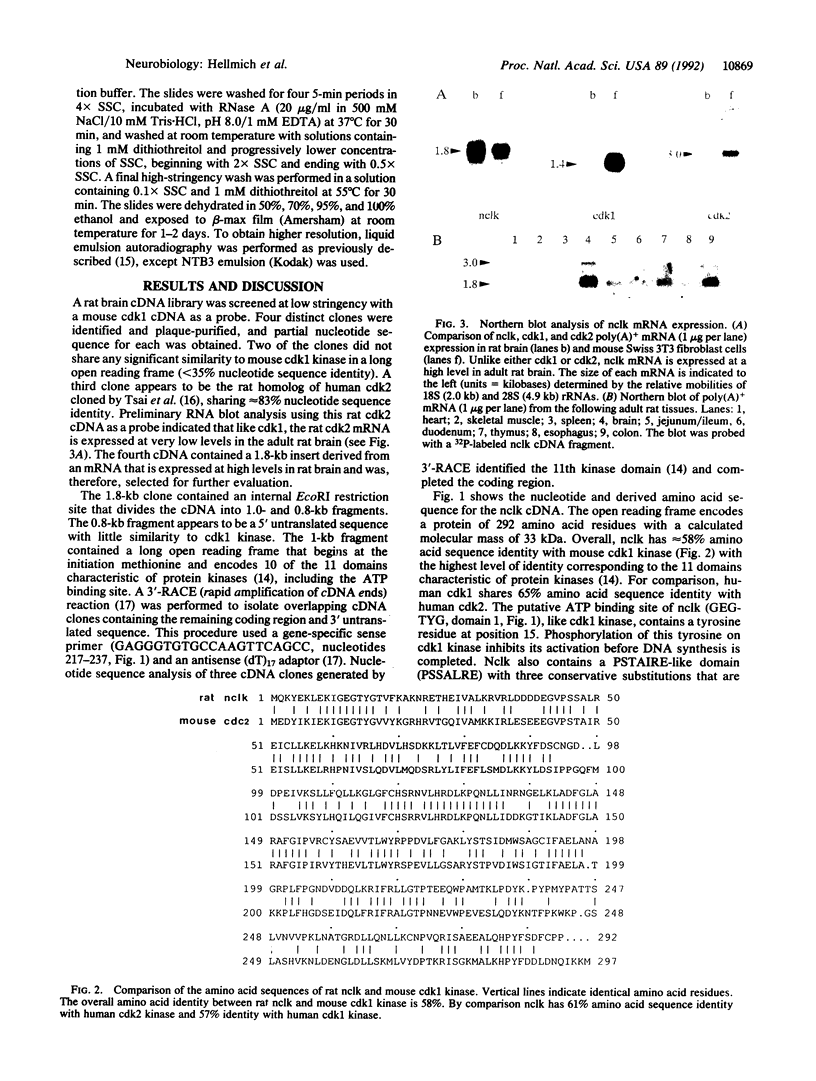
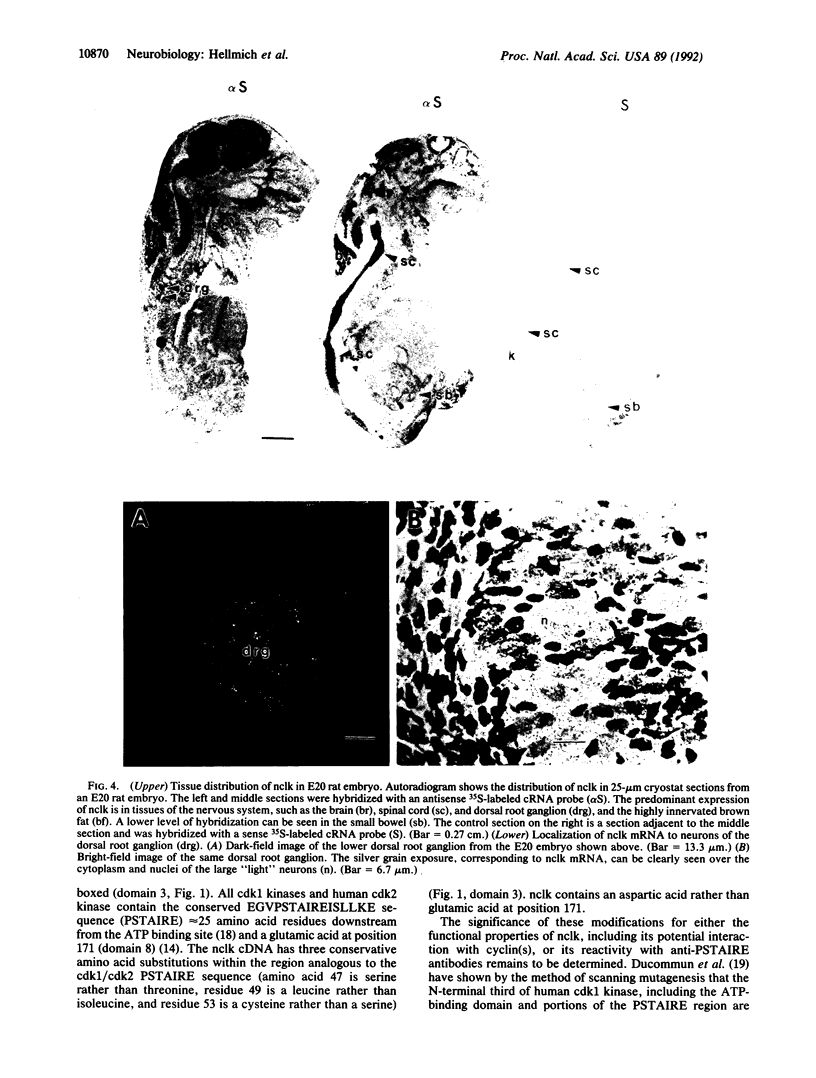
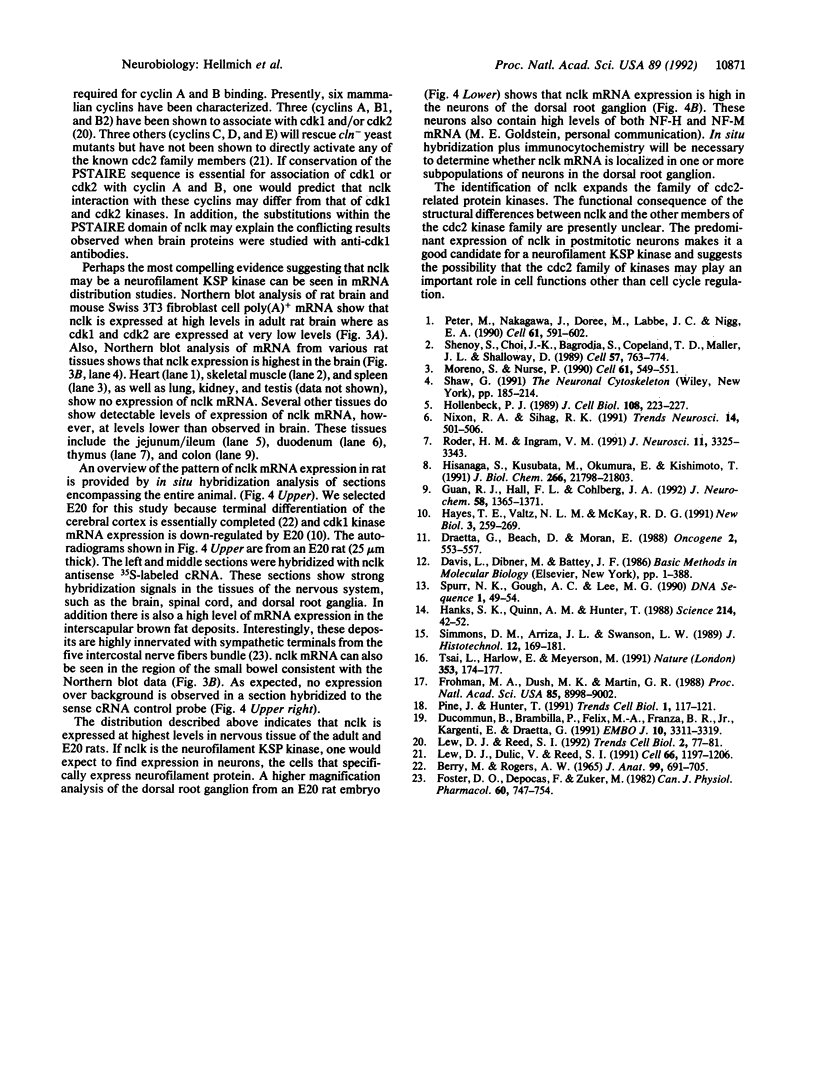
Images in this article
Selected References
These references are in PubMed. This may not be the complete list of references from this article.
- Draetta G., Beach D., Moran E. Synthesis of p34, the mammalian homolog of the yeast cdc2+/CDC28 protein kinase, is stimulated during adenovirus-induced proliferation of primary baby rat kidney cells. Oncogene. 1988 Jun;2(6):553–557. [PubMed] [Google Scholar]
- Ducommun B., Brambilla P., Félix M. A., Franza B. R., Jr, Karsenti E., Draetta G. cdc2 phosphorylation is required for its interaction with cyclin. EMBO J. 1991 Nov;10(11):3311–3319. doi: 10.1002/j.1460-2075.1991.tb04895.x. [DOI] [PMC free article] [PubMed] [Google Scholar]
- Foster D. O., Depocas F., Zuker M. Heterogeneity of the sympathetic innervation of rat interscapular brown adipose tissue via intercostal nerves. Can J Physiol Pharmacol. 1982 Jun;60(6):747–754. doi: 10.1139/y82-104. [DOI] [PubMed] [Google Scholar]
- Frohman M. A., Dush M. K., Martin G. R. Rapid production of full-length cDNAs from rare transcripts: amplification using a single gene-specific oligonucleotide primer. Proc Natl Acad Sci U S A. 1988 Dec;85(23):8998–9002. doi: 10.1073/pnas.85.23.8998. [DOI] [PMC free article] [PubMed] [Google Scholar]
- Guan R. J., Hall F. L., Cohlberg J. A. Proline-directed protein kinase (p34cdc2/p58cyclin A) phosphorylates bovine neurofilaments. J Neurochem. 1992 Apr;58(4):1365–1371. doi: 10.1111/j.1471-4159.1992.tb11351.x. [DOI] [PubMed] [Google Scholar]
- Hanks S. K., Quinn A. M., Hunter T. The protein kinase family: conserved features and deduced phylogeny of the catalytic domains. Science. 1988 Jul 1;241(4861):42–52. doi: 10.1126/science.3291115. [DOI] [PubMed] [Google Scholar]
- Hayes T. E., Valtz N. L., McKay R. D. Downregulation of CDC2 upon terminal differentiation of neurons. New Biol. 1991 Mar;3(3):259–269. [PubMed] [Google Scholar]
- Hisanaga S., Kusubata M., Okumura E., Kishimoto T. Phosphorylation of neurofilament H subunit at the tail domain by CDC2 kinase dissociates the association to microtubules. J Biol Chem. 1991 Nov 15;266(32):21798–21803. [PubMed] [Google Scholar]
- Hollenbeck P. J. The transport and assembly of the axonal cytoskeleton. J Cell Biol. 1989 Feb;108(2):223–227. doi: 10.1083/jcb.108.2.223. [DOI] [PMC free article] [PubMed] [Google Scholar]
- Lew D. J., Dulić V., Reed S. I. Isolation of three novel human cyclins by rescue of G1 cyclin (Cln) function in yeast. Cell. 1991 Sep 20;66(6):1197–1206. doi: 10.1016/0092-8674(91)90042-w. [DOI] [PubMed] [Google Scholar]
- Lew D. J., I Reed S. A proliferation of cyclins. Trends Cell Biol. 1992 Mar;2(3):77–81. doi: 10.1016/0962-8924(92)90076-y. [DOI] [PubMed] [Google Scholar]
- Moreno S., Nurse P. Substrates for p34cdc2: in vivo veritas? Cell. 1990 May 18;61(4):549–551. doi: 10.1016/0092-8674(90)90463-o. [DOI] [PubMed] [Google Scholar]
- Nixon R. A., Sihag R. K. Neurofilament phosphorylation: a new look at regulation and function. Trends Neurosci. 1991 Nov;14(11):501–506. doi: 10.1016/0166-2236(91)90062-y. [DOI] [PubMed] [Google Scholar]
- Peter M., Nakagawa J., Dorée M., Labbé J. C., Nigg E. A. In vitro disassembly of the nuclear lamina and M phase-specific phosphorylation of lamins by cdc2 kinase. Cell. 1990 May 18;61(4):591–602. doi: 10.1016/0092-8674(90)90471-p. [DOI] [PubMed] [Google Scholar]
- Pines J., Hunter T. Cyclin-dependent kinases: a new cell cycle motif? Trends Cell Biol. 1991 Nov;1(5):117–121. doi: 10.1016/0962-8924(91)90116-q. [DOI] [PubMed] [Google Scholar]
- Roder H. M., Ingram V. M. Two novel kinases phosphorylate tau and the KSP site of heavy neurofilament subunits in high stoichiometric ratios. J Neurosci. 1991 Nov;11(11):3325–3343. doi: 10.1523/JNEUROSCI.11-11-03325.1991. [DOI] [PMC free article] [PubMed] [Google Scholar]
- Shenoy S., Choi J. K., Bagrodia S., Copeland T. D., Maller J. L., Shalloway D. Purified maturation promoting factor phosphorylates pp60c-src at the sites phosphorylated during fibroblast mitosis. Cell. 1989 Jun 2;57(5):763–774. doi: 10.1016/0092-8674(89)90791-5. [DOI] [PubMed] [Google Scholar]
- Spurr N. K., Gough A. C., Lee M. G. Cloning of the mouse homologue of the yeast cell cycle control gene cdc2. DNA Seq. 1990;1(1):49–54. doi: 10.3109/10425179009041346. [DOI] [PubMed] [Google Scholar]
- Tsai L. H., Harlow E., Meyerson M. Isolation of the human cdk2 gene that encodes the cyclin A- and adenovirus E1A-associated p33 kinase. Nature. 1991 Sep 12;353(6340):174–177. doi: 10.1038/353174a0. [DOI] [PubMed] [Google Scholar]




